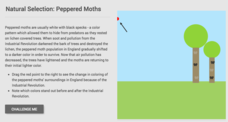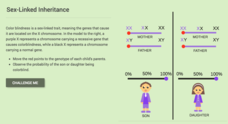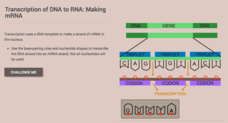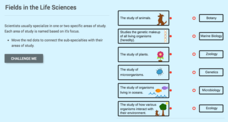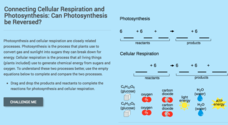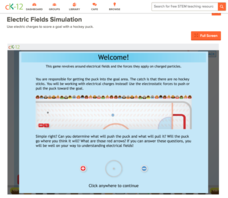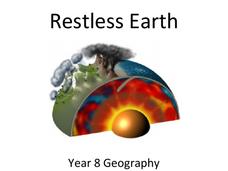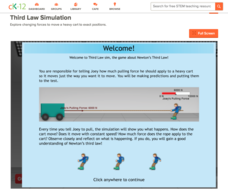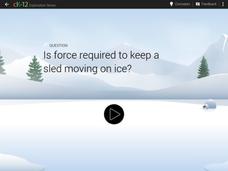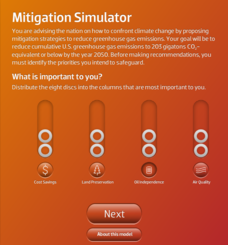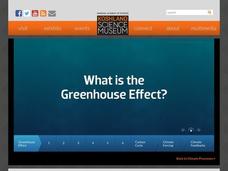CK-12 Foundation
Natural Selection: Of Seasons and Species
Do predators look for different things in different seasons? The quick interactive shows how some species survive longer in one season than another based on the conditions. The challenge questions encourage pupils to demonstrate that...
CK-12 Foundation
Natural Selection: Peppered Moths
Can human activity influence the colors of moths? The simulation explains how pollution changed the color of tree bark, which led to the survival of a different variation of moths. It also discusses the shift back as air quality improves.
CK-12 Foundation
Natural Selection: Natural Disasters
Can natural disasters alter natural selection? The interactive explores this concept with mice living through a forest fire. As the environment changes, the camouflage also changes. How does this one disaster impact future generations?
CK-12 Foundation
Sex-Linked Inheritance
Sex-linked traits indicate a gene's location on a specific chromosome. Scholars learn about sex-linked traits and the specifics behind color blindness in the videos. Then they complete the online interactive to apply their knowledge...
CK-12 Foundation
Modern Genetics
Genetic counselors advise their clients on the chance of passing specific diseases on to their children. Pupils learn about genotypes, phenotypes, and genetics in the lesson. Matching activities, multiple-choice questions, and a...
CK-12 Foundation
Transcription of DNA to RNA: Making mRNA
Transcription means a written copy but how can DNA write a message? The video explains transcription and translation as they relate to DNA and RNA. Then in the interactive, scholars practice base pairing and answer analysis...
CK-12 Foundation
Cell Cycle: Phases of the Cell Cycle
Eukaryotic cells go through a cycle of creation, reproduction, and death. The video choreographs the cell cycle to music from a popular movie. This prepares scholars to answer the questions in the online interactive.
CK-12 Foundation
Passive Transport
Some molecules move through a membrane with diffusion while others require protein channels. The video and interactive discuss both types of passive transport. Challenge questions allow scholars to demonstrate their understanding.
CK-12 Foundation
Microscopes: Focal Point
The 1590s saw the invention of the first compound microscope. Scholars learn about how microscopes work and how to properly focus one. The lesson stresses the science fields that use microscopes and the difference between electron...
CK-12 Foundation
Fields in the Life Sciences
Many fields of study require a specialty and a sub-specialty as you progress through your education. Scholars learn about six sub-specialties of life science. From botany to zoology, our knowledge of the world of living organisms expands...
CK-12 Foundation
Symbiosis: Mutualism, Commensalism, and Parasitism
Hyenas normally hunt alone, however scientists discovered that in Israel, hyenas hunt with wolf packs. When relationships develop between different species, we call it symbiosis. The videos teach about the three types of symbiosis and an...
CK-12 Foundation
Cellular Respiration: Can Photosynthesis Be Reversed?
Cellular respiration and photosynthesis relate closely, but many don't realize how. Scholars drag and drop the reactants and products to the chemical reactions for both processes. Then they answer three multiple-choice questions.
University of Minnesota
Beautiful Brain: Step Inside the Brain
Before digital microscopes, scientists hired artists to draw the things visible in the microscope. Through training in neuroscience and art, Cajal revolutionized the way we view the beautiful brain. The third lesson in a series of four...
University of Minnesota
Beautiful Brain: Do You See What I See?
Can art play tricks on your eyes, and can a still painting really appear to vibrate? The second lesson in a four-part series discusses the way our beautiful brains translate visual images. It highlights the style of optical art and...
University of Minnesota
Beautiful Brain: Brain Inspiration
"Neuroscientists consider Cajal as important to their discipline as Einstein is to physics." The first of four lessons has scholars view Santiago Ramon y Cajal's drawings of neurons. They reflect and respond to the art through writing...
CK-12 Foundation
Electric Fields Simulation
Can you get the puck into the goal using only electric charges on the ice? Scholars experiment with electrostatic forces as they determine which charges pull the puck and which repel it. Multiple levels reinforce different related...
CK-12 Foundation
Electric Ice Sheet
Tommy is trapped on an ice bridge and needs you to balance the charges so he doesn't fall into the icy water! Scholars apply Coulomb's Law, which relates to both the strength and the distance between charges. They work with these two...
CK-12 Foundation
Energy Conservation Simulation
Does the amount of a roller coaster's energy change as it goes along the track? Scholars investigate when a roller coaster has potential and kinetic energy. They observe the changes as it goes up the initial hill follows it throughout...
Geographer Online
Restless Earth
In less than 25 years, the continent of Australia moved 4.9 feet thanks to plate tectonics. The presentation introduces the idea of the layers of the earth as well as plate tectonics. It goes into why the plates move and where we believe...
CK-12 Foundation
Third Law Simulation
Keep calm and use the force! Joey pulls a cart and scholars adjust the force required to control the movement. Through simulating different scenarios, participants learn about Newton's Third Law. It includes analysis questions throughout...
CK-12 Foundation
First Law Simulation
Does Newton's First Law of Motion explain how to move a sled across ice? A simulation encourages scholars to decide if they should push, pull, or apply no force. Their decision moves a sled across the ice and to the home at the...
National Academy of Sciences
Mitigation Simulator
The United States has more per capita emissions than any other country in the world. An eye-opening simulation encourages users to explore environmental goals and factors that affect climate change by balancing different priorities....
National Academy of Sciences
CO2 and Temperature
Scientists can model global surface temperature with and without considering human emissions, but does do these factors really make a difference? Two interactive graphs demonstrate some factors that affect climate change. The first graph...
National Academy of Sciences
What is the Greenhouse Effect?
The greenhouse effect warms up earth enough so it can support life, but if it heats up too much, life won't be able to survive. An interactive presentation covers the greenhouse effect, the carbon cycle, climate forcing, and climate...



